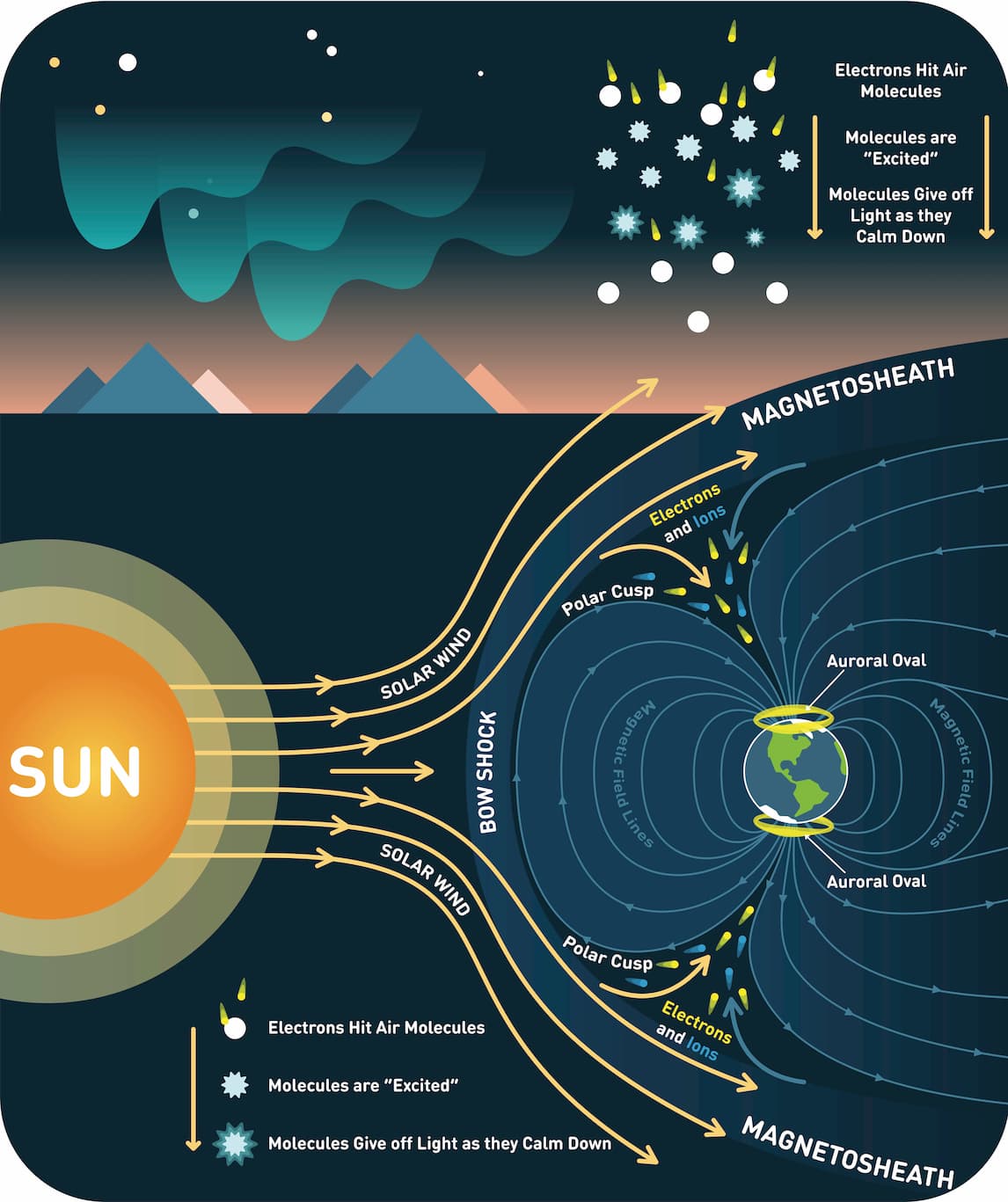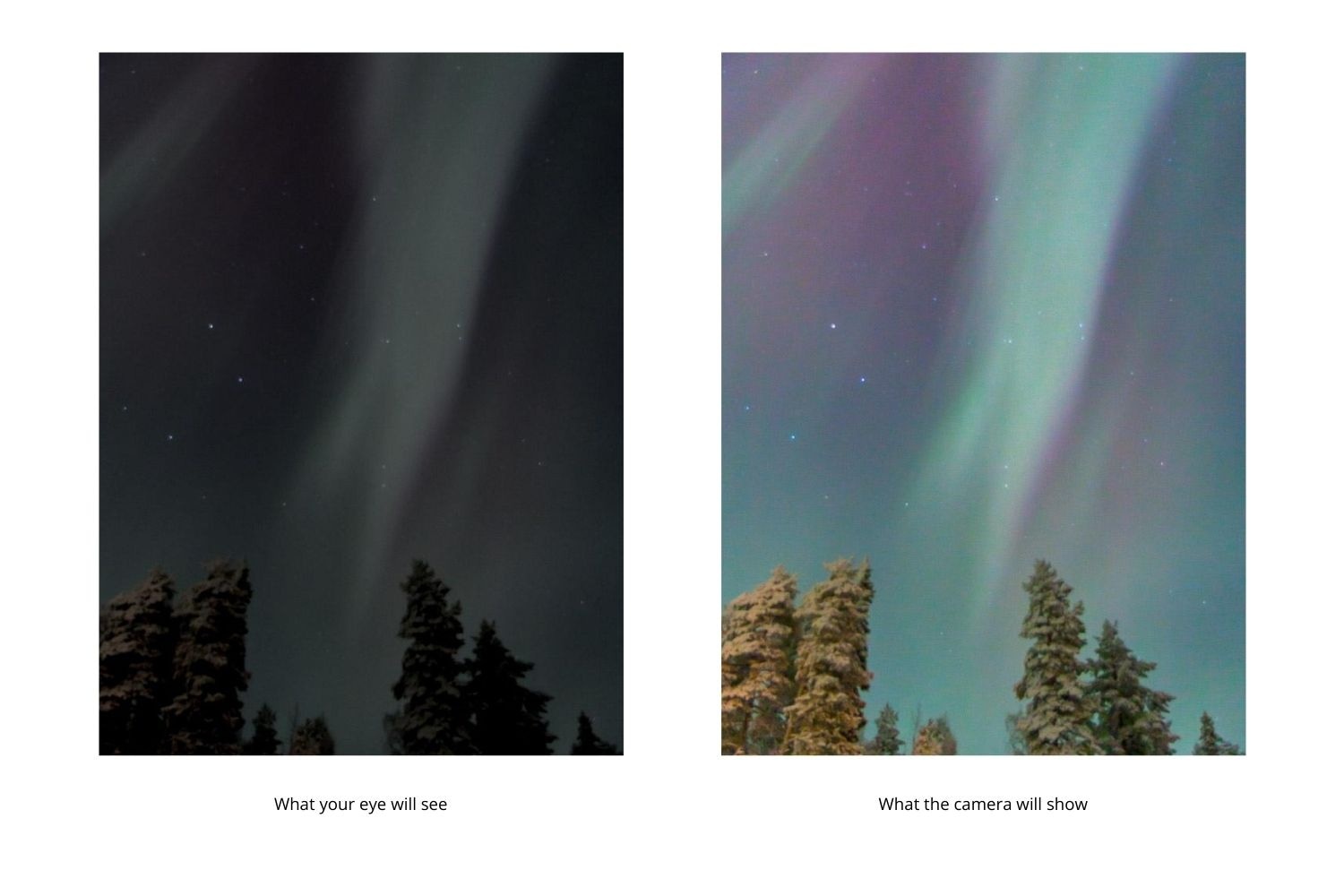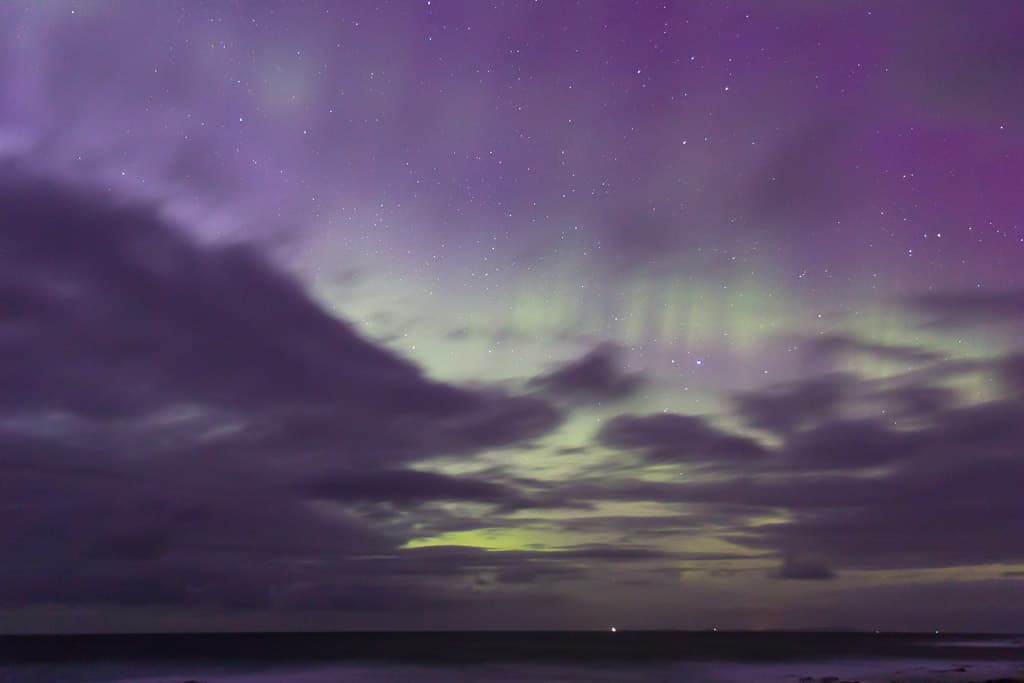How to find the Northern Lights
Aurora hunting is an addictive pastime and trying to find the Northern Lights can be a memorable experience. Once you have seen the northern lights you will always want more.
However, finding these elusive lights in the night sky isn’t as easy as you may think. Effort is needed to find the perfect location, time your visit right and keep warm and safe.
While the northern lights are on most people’s bucket lists there are also lights in the southern hemisphere called the Southern Lights or Aurora Australis.

This article contains links to products and services that I think you will find useful. I may earn a commission on any purchases you make at no cost to you. As an Amazon Associate, I earn from qualifying purchases. Read more HERE
What are the northern lights
To start off, here is a little science lesson with a very simplified version of events!
The sun is constantly in turmoil and periodically ejects gasses from its surface from areas known as sunspots.
These clouds of ejected particles, known as solar wind travel through space and when the energy interacts with the Earth’s magnetic field the electrons in the gases become excited and glow.
The colour of the aurora will depend on the gases involved and the height above the earth’s surface where the interaction occurs. The movement of the lights will change depending on how the solar wind and earth’s magnetic field interact.
Interactions with oxygen will result in green and yellow lights while nitrogen in the atmosphere will give reds and violets. The further north you are when viewing this interaction the more that will be visible.
In Scotland there may be just a glow on the horizon like a green sunset at the wrong time of day, in Scandinavia there may be overhead displays or even lights in the southern sky. The degree of light will depend on the energy of the solar wind, the direction of the solar wind and ultimately the cloud cover where you are.
The lights that are visible are between 60km and 250km above the surface of the earth and happen throughout the year whenever the sun is ‘active’, but low cloud and daylights means that they are not always visible.

What to look for when aurora hunting
First of all, you need to look north. This may sound simple, but in a dark landscape, it is easy to become disorientated. The northern lights don’t always look green. It is only the really intense displays that look green to the naked eye.
A lot of the time the northern lights will appear as a weird white cloud that is moving in waves across the sky. Normal clouds will obscure the stars but with an aurora, the stars will still be visible.
As the display intensifies the colours will start to appear and this is when the colours will start to become more visible. Even when you cannot see the northern lights well they can be detected on a camera.

The sensor on the camera detects far more light than your eye can and this can give the intense images that are seen of the northern lights. They are not manipulated or ‘photoshopped’.
The northern lights have four distinct appearances – arcs, bands, pillars and corona
Aurora arc
This is seen as the energy starts to build. It is seen a lot of the time at lower altitudes as the bands and pillars develop further north. An arc can slowly develop into curtains or pillars over time as the energy builds. If you are under an arc you will see large swathes of colour but it is poorly defined, unlike the bands and pillars.

Bands or Curtains of Northern Lights
The ribbons of northern lights are what is usually associated with the displays. These curtains of colour hang in the air and appear to dance across the sky. In Orkney, the northern lights are known as the ‘Mirrie Dancers”.

At low energy, they will undulate or pulse across the sky with movement intensifying as the energy increases. Initially, it will be quite diffuse but as the energy increases they will begin to form more distinct bands. As the display progresses the bands shrink together and start to form pillars.
Pillars
The pillars are seen when the energy levels are at their most intense. Sometimes these can reach 600km from green to red and streak into the sky. At lower altitudes, it may be just the pillars that are seen when the activity is high.

Coronas
These are probably the rarest forms of aurora display that are seen. They occur when you are right beneath a pillar looking straight up into what looks like a zenith or crown of the aurora. This gives a weird and unusual perspective. These usually occur when there is a large substorm going on.

How to track and find the northern lights
Not many things that you plan in life are so unpredictable and totally out of your control. Even wildlife encounters can be engineered in some way to make sure it happens but the aurora really are their own boss.
Planning a trip to see the northern lights is a winter bucket list adventure but you should have alternative plans in case of cloud cover or low solar activity. You should plan a visit to the northern lights as a bonus, not the sole reason. The tips below will help increase your chances of seeing the northern lights.
How do you know when the northern lights are going to appear?
The northern lights are predictable to a certain extent but the amount of a display will vary even when all the factors are in the right place. To tell if the northern lights are going to appear you need to know whether the sun has been active, whether there is cloud cover that will hide them and also ensure that you are far enough north with a dark sky. The northern lights will not appear in daylight so in summer months they may not be seen when there is the midnight sun.
Northern latitude with a clear horizon to the north
The best places to see aurora are in the far north at high latitudes. As a general guide anywhere within the Arctic Circle is good. 66°N in Scandinavia and 69°N in North America is a good guide to follow to ensure that even if the Kp storm index is low there is still a chance. Further south it is still possible but the solar activity needs to be higher to see any northern lights.
The lights form a circle around the pole, so there is a point at which you are too far north to see them as well. There is a chart called the Ovation Auroral Forecast. This will show a short-term forecast of where the aurora will be visible. It is very general and accuracy is to within 1000km, but it is a good starting point.
See the Ovation Auroral Forecast HERE.
You will also need to ensure that you are somewhere that has a clear view north. The northern lights, unless it is a large storm will be visible on the northern horizon, so make sure you aren’t on the south side of a large hill when you start looking for them!
Best time of year to see the aurora
The northern lights are visible in the winter months when there are dark skies. In the UK and lower latitudes, this is from late August until mid-May (apart from a mad June night on Skomer Island in Wales!). However, the further north you head the later in the year the dark skies appear. At higher latitudes, the aurora season doesn’t really get going until September and sometimes later lasting through to March. There are some thoughts that the activity of the sun is more volatile with more aurora around the equinox but this may be a coincidence more than anything.

Choosing the right time of day and night to Look for Aurora
Obviously, it needs to be dark before you see the aurora, but there is no way to predict when they will become visible. If the activity is high then as soon as the sun sets it may be visible, at other times it may be two in the morning before they are visible. Staying somewhere with clear skies will increase your chances as you can stay warm and watch the skies. Nothing is worse than staying out until the early hours, getting to bed and finding out they appeared an hour later (believe me it is not a good feeling!). Some hotels offer an aurora wake-up call which is worth considering!
Avoid light pollution
Light pollution is one of the main causes of not seeing the northern lights or not having them live up to expectations. To see the aurora you need a dark sky. This means a proper dark sky. Any light from habitation, especially the sodium glare seen in bigger cities can dilute the intensity of the northern lights to a point that they become invisible. Many places in Reykjavík or Tromsø push themselves as being ideal for the northern lights but even here you need to get out of the city to see the lights at their best. If you are looking to book somewhere with the chance of light pollution you really do need to be getting out of town and away from habitation.

Check the phase of the moon
Leading on from light pollution is the moon. When you are planning a trip to see the aurora then plan to go when there is no moon. As the moon becomes fuller, the brightness increases and in a similar way to the sodium lights from cities, the moon can overpower the intensity of the northern lights. Check for when the full moon is happening or when the moonrise is outside of the times when the aurora is most active.
Check out the phase of the moon for your visit HERE
If you do happen to see the northern lights when there is a full moon it can give a totally different appearance to photographs. The moon will illuminate the foreground in its bright light, perfect for showing people or the landscape with the colours of the lights in the background.
Use a local guide
Having a guide who knows the area, knows the weather patterns and knows how the aurora will behave is worth paying for. Choose someone who is local rather than an ‘expert’ who visits the area for a few weeks each year to guide small groups. A local guide will also understand the weather conditions. Guiding a group in sub-zero temperatures is very different to guiding a group in the English countryside and in the Arctic Circle, the weather conditions can change in minutes. As always make sure they have good reviews and what times they will take you out so you get the maximum chance of seeing the lights.
Learn about Kp and the aurora zone
Whilst there are lots of ways to predict the northern lights involving graphs and charts a really simple way to see if you are in luck is using Kp. Kp is a measure of solar activity and solar storms. This is not the most accurate way to identify the appearance of the lights but is quick and easy.
When the Kp is low, the sun is inactive and the aurora is less intense. As the Kp number increases towards 9, the northern lights will become more visible and brighter. As a general rule, the higher the number the further south the lights will be visible. In the south of England for example, a Kp of 6 will mean the lights are visible if all other factors are in line.
Most solar storms are around Kp1 to 3, meaning that the lights are only visible at the higher latitudes 66°N in Scandinavia and 69°N in North America (the aurora zone oval is a different shape in North America).
In the far north, even on days where the Kp is 0, there is a chance of a display as there are other factors that come into play. For the best predictions in Europe follow the Aurora Alerts website where regular updates are made.
Check my favourite aurora prediction website HERE
Clear skies and finding them
Before heading out for a night of aurora hunting you should check the cloud cover. There is nothing worse than being clouded in and stuck. If you are serious about seeing the lights then you need to be mobile.
This may be with a nice van and a guide or it may be on a quad bike or even a dog sledge if you are really adventurous. The key however is to be able to move to areas that are cloud-free with clear skies. Again, local knowledge will help make this possible and ensure you use your time well maximising your chances to see the lights.
There are some really good apps available including Clear Outside which is great for night sky photography.

How long do the northern lights last for?
Displays of the northern lights can last from a few minutes to an hour or more. Most good displays are about 30 minutes. There is no way to predict when the display will be over and much of the time the lights will build and then fade only to return a short while later. It is often worth staying out even if the display is fading as they may return for an even better display.
Have fun and enjoy the experience
At the end of the day, even if you only catch a glimpse, being out at night in the Arctic is an experience that is like no other. The silence, the stars as well and the chill all make this a fantastic moment that shouldn’t be missed.

